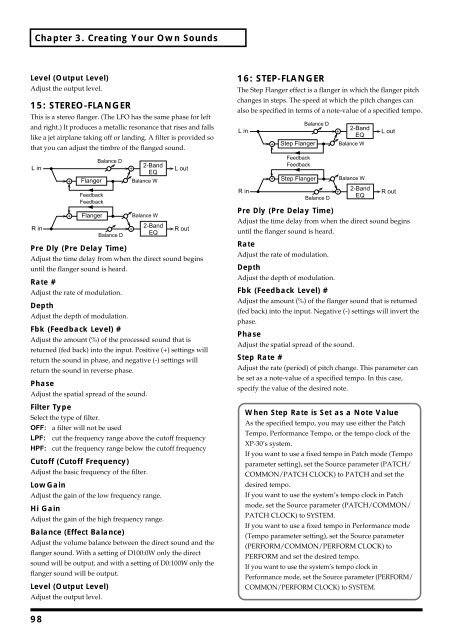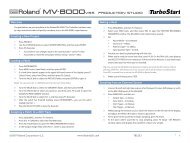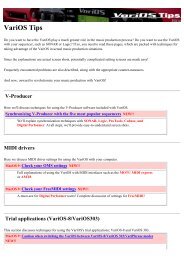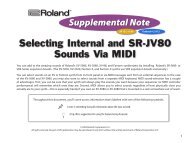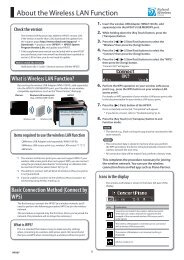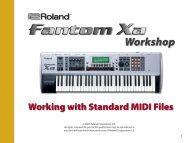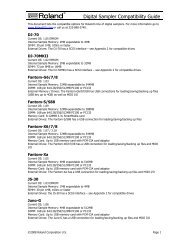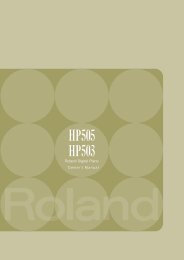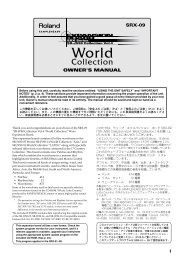You also want an ePaper? Increase the reach of your titles
YUMPU automatically turns print PDFs into web optimized ePapers that Google loves.
Chapter 3. Creating Your Own Sounds<br />
Level (Output Level)<br />
Adjust the output level.<br />
15: STEREO-FLANGER<br />
This is a stereo flanger. (The LFO has the same phase for left<br />
and right.) It produces a metallic resonance that rises and falls<br />
like a jet airplane taking off or landing. A filter is provided so<br />
that you can adjust the timbre of the flanged sound.<br />
fig.3-62<br />
L in<br />
R in<br />
Pre Dly (Pre Delay Time)<br />
Adjust the time delay from when the direct sound begins<br />
until the flanger sound is heard.<br />
Rate #<br />
Adjust the rate of modulation.<br />
Depth<br />
Adjust the depth of modulation.<br />
Fbk (Feedback Level) #<br />
Adjust the amount (%) of the processed sound that is<br />
returned (fed back) into the input. Positive (+) settings will<br />
return the sound in phase, and negative (-) settings will<br />
return the sound in reverse phase.<br />
Phase<br />
Adjust the spatial spread of the sound.<br />
Filter Type<br />
Select the type of filter.<br />
OFF: a filter will not be used<br />
LPF: cut the frequency range above the cutoff frequency<br />
HPF: cut the frequency range below the cutoff frequency<br />
Cutoff (Cutoff Frequency)<br />
Adjust the basic frequency of the filter.<br />
LowGain<br />
Adjust the gain of the low frequency range.<br />
Hi Gain<br />
Flanger<br />
Feedback<br />
Feedback<br />
Flanger<br />
Balance D<br />
Adjust the gain of the high frequency range.<br />
Balance (Effect Balance)<br />
Adjust the volume balance between the direct sound and the<br />
flanger sound. With a setting of D100:0W only the direct<br />
sound will be output, and with a setting of D0:100W only the<br />
flanger sound will be output.<br />
Level (Output Level)<br />
Adjust the output level.<br />
Balance D<br />
2-Band<br />
EQ<br />
Balance W<br />
Balance W<br />
2-Band<br />
EQ<br />
L out<br />
R out<br />
16: STEP-FLANGER<br />
The Step Flanger effect is a flanger in which the flanger pitch<br />
changes in steps. The speed at which the pitch changes can<br />
also be specified in terms of a note-value of a specified tempo.<br />
fig.3-62a<br />
L in<br />
R in<br />
Step Flanger<br />
Feedback<br />
Feedback<br />
Step Flanger<br />
Balance D<br />
Balance D<br />
2-Band<br />
EQ<br />
Balance W<br />
Balance W<br />
2-Band<br />
EQ<br />
L out<br />
R out<br />
Pre Dly (Pre Delay Time)<br />
Adjust the time delay from when the direct sound begins<br />
until the flanger sound is heard.<br />
Rate<br />
Adjust the rate of modulation.<br />
Depth<br />
Adjust the depth of modulation.<br />
Fbk (Feedback Level) #<br />
Adjust the amount (%) of the flanger sound that is returned<br />
(fed back) into the input. Negative (-) settings will invert the<br />
phase.<br />
Phase<br />
Adjust the spatial spread of the sound.<br />
Step Rate #<br />
Adjust the rate (period) of pitch change. This parameter can<br />
be set as a note-value of a specified tempo. In this case,<br />
specify the value of the desired note.<br />
When Step Rate is Set as a Note Value<br />
As the specified tempo, you may use either the Patch<br />
Tempo, Performance Tempo, or the tempo clock of the<br />
XP-30’s system.<br />
If you want to use a fixed tempo in Patch mode (Tempo<br />
parameter setting), set the Source parameter (PATCH/<br />
COMMON/PATCH CLOCK) to PATCH and set the<br />
desired tempo.<br />
If you want to use the system’s tempo clock in Patch<br />
mode, set the Source parameter (PATCH/COMMON/<br />
PATCH CLOCK) to SYSTEM.<br />
If you want to use a fixed tempo in Performance mode<br />
(Tempo parameter setting), set the Source parameter<br />
(PERFORM/COMMON/PERFORM CLOCK) to<br />
PERFORM and set the desired tempo.<br />
If you want to use the system’s tempo clock in<br />
Performance mode, set the Source parameter (PERFORM/<br />
COMMON/PERFORM CLOCK) to SYSTEM.<br />
98


